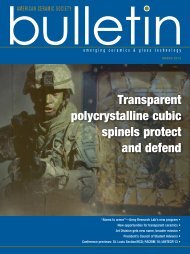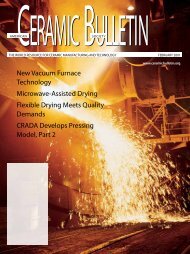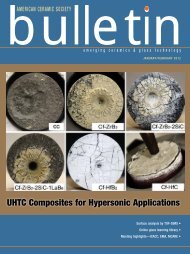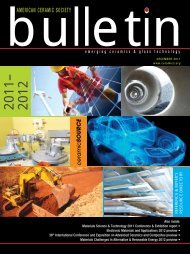American Ceramic Society Bulletin
American Ceramic Society Bulletin
American Ceramic Society Bulletin
You also want an ePaper? Increase the reach of your titles
YUMPU automatically turns print PDFs into web optimized ePapers that Google loves.
advances in nanomaterials<br />
Bioactive cement plaster: Bioengineering in action<br />
For some time, it has been common<br />
to use enzymes as biocatalysts. When<br />
the enzymes required are difficult or<br />
expensive to extract, the utilization of<br />
microorganisms such as bacteria, yeast,<br />
or fungi is an alternative.<br />
Also from Berkeley Lab (see previous<br />
story), we received word about<br />
work there regarding spontaneous magnetization<br />
in bismuth ferrite, another<br />
multiferroic material.<br />
What seems to have researchers<br />
really excited is that they can turn this<br />
magnetization on and off via an external<br />
electric field at room temperature,<br />
making the BFO a possible material<br />
for spintronic applications.<br />
In a news release from the lab,<br />
Ramamoorthy Ramesh, the materials<br />
scientist with the lab’s Materials Sciences<br />
Division who led this research,<br />
explains the novel approach taken. He<br />
says, “[W]e’ve created a new magnetic<br />
state in bismuth ferrite along with<br />
the ability to electrically control this<br />
magnetism at room temperature. An<br />
enhanced magnetization arises in the<br />
rhombohedral phases of our bismuth<br />
ferrite self-assembled nanostructures.<br />
This magnetization is strain-confined<br />
between the tetragonal phases of the<br />
material and can be erased by the<br />
application of an electric field. The<br />
magnetization is restored when the<br />
polarity of the electric field is reversed.”<br />
In 2009, Ramesh and his research<br />
group looked at thin films of the BFO<br />
and found that although bismuth ferrite<br />
is an insulator, two of three domain<br />
wall orientations in the material conduct<br />
electricity. They subsequently<br />
found that application of a large epitaxial<br />
strain changes the BFO crystal<br />
structure from a predominant rhombohedral<br />
phase to a tetragonal phase.<br />
Conversely, a partial strain reduction<br />
produces a nanoscale mixed phase<br />
For many applications, the living<br />
cells are immobilized within a stable<br />
matrix system. This prevents the<br />
embedded cells against culture washout<br />
and protects them from external<br />
impact, such as shear forces, pH or sol-<br />
Spintronics may get boost from enhanced magnetism in BFO films<br />
AFM image of a mixed-phase bismuth<br />
ferrite sample. The red and green areas<br />
indicate phase regions oriented at 90<br />
degrees to each other.<br />
composed of the rhombohedral and<br />
tetragonal phases. Ramesh says the<br />
mixture can be stable, with the rhombohedral<br />
phases mechanically confined<br />
by regions of the tetragonal phases.<br />
As a result of the interaction, a<br />
different magnetic moment (30 to 40<br />
electromagnetic units per cubic centimeter)<br />
spontaneously arises within<br />
the distorted rhombohedral phase, one<br />
that is qualitatively stronger than the<br />
magnetic moment of fully rhombohedral<br />
BFO (6 to 8 electromagnetic units<br />
per cubic centimeter).<br />
Ramesh says these differences are<br />
large enough to be put to use, and can<br />
be manipulated using an external electrical<br />
field rather than applying the<br />
magnetic field used in conventional<br />
memory devices.<br />
The results of the group’s work<br />
is published Nature Communications<br />
(doi:10.1038/ncomms1221).<br />
Visit: www.lbl.gov n<br />
vents. Besides commonly used natural<br />
polymers, some porous inorganic matrices<br />
have become increasingly important<br />
for immobilizing living cells.<br />
Results of former studies have shown<br />
that bacteria can be successfully embedded<br />
within a very hard concrete matrix<br />
and can remain viable for a period of<br />
four months. This encouraged the R&D<br />
organization GMBU and the company<br />
InnoTERE (both Dresden, Germany) to<br />
investigate the immobilization of microorganisms<br />
in cements. The researchers<br />
examined the viability and biocatalytic<br />
applicability of the bacteria Rhodococcus<br />
ruber and the yeast Saccharomyces<br />
cerevisiae, in particular their dependence<br />
on preparation conditions.<br />
For their investigations, they used<br />
magnesium phosphate cement, which<br />
can be prepared easily by mixing hardburned<br />
tribasic magnesium phosphate<br />
powder and ammonium phosphate<br />
solution. Because of the stiffness of the<br />
cement matrix, bioactive MPC could<br />
be very interesting for applications in<br />
bioremediation, in biotechnology as<br />
bulk material in large columns or reactive<br />
walls, or as bioactive cement plaster<br />
within sewers.<br />
The results of the study, “Cements<br />
with embedded living microorganisms:<br />
A new class of biocatalytic composite<br />
materials for application in bioremediation,<br />
biotechnology” (doi:10.1002/<br />
adem.201080040) revealed that the<br />
bioactive composite material exhibits<br />
good mechanical and chemical stability.<br />
The embedded cells survived the<br />
embedding within the cement matrix<br />
even though the cements showed much<br />
slower glucose and phenol consumption<br />
in comparison with nonimmobilized<br />
cells.<br />
Combining a cement matrix with<br />
living microorganisms is a promising<br />
method to fabricate biocomposite materials<br />
for application in biotechnology.<br />
Visit: InnoTere, www.innotere.de;<br />
and GMBU, www.gmbu.de n<br />
16 <strong>American</strong> <strong>Ceramic</strong> <strong>Society</strong> <strong>Bulletin</strong>, Vol. 90, No. 4<br />
(Credit: Ramesh Group; Berkeley Lab.)






